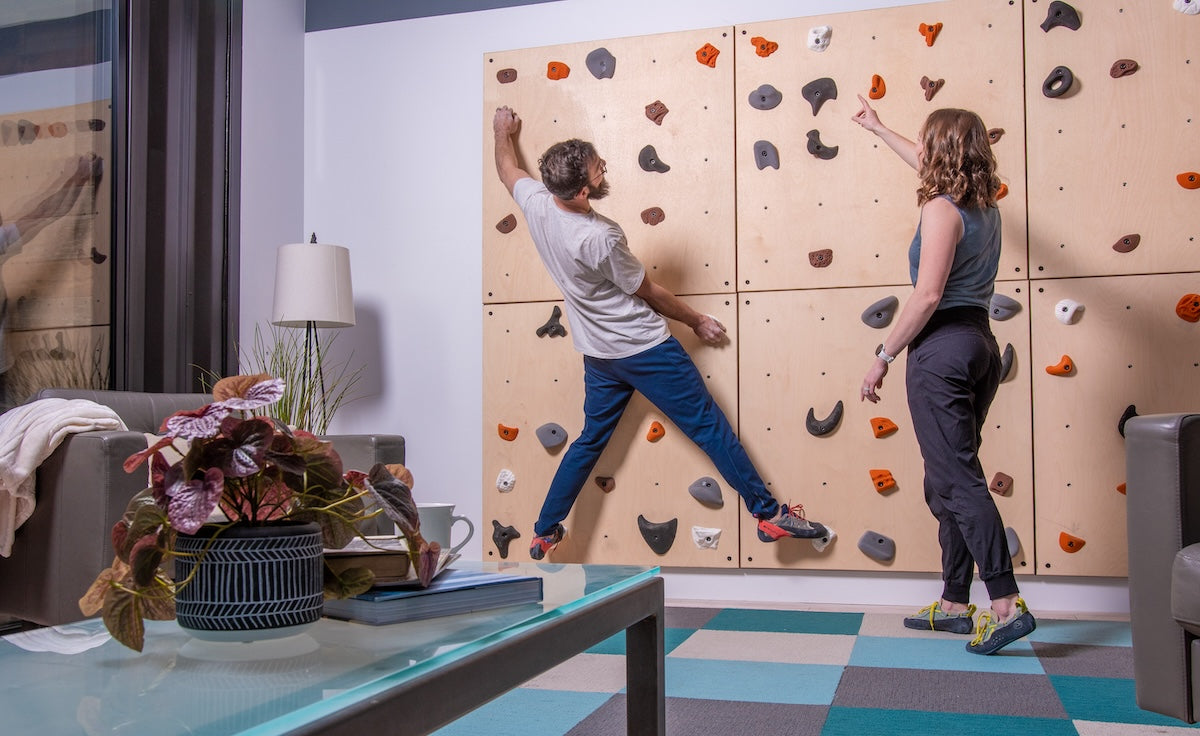Indoor Home Rock Climbing Wall: Setup & Safety Guide

Transforming your home into a climbing enthusiast’s dream with an indoor rock climbing wall not only elevates your fitness regime but also introduces an adventurous element to your living space.
With the rise of indoor climbing's popularity, integrating a climbing wall at home has become a sought-after feature for those looking to merge lifestyle, leisure, fitness, and the challenge of climbing.
The Appeal of an Indoor Rock Climbing Wall
A Fitness Revolution at Home
The convenience of a home-based climbing wall cannot be overstated. It offers a unique workout that combines strength training, flexibility, and mental strategy.
Unlike traditional home gyms, an indoor rock climbing wall invites a novel approach to fitness, making exercise not just a routine but an engaging and thrilling challenge that can be modified over time..
Design Meets Functionality
Beyond the physical benefits, these walls are a testament to modern design, capable of transforming any room into a visually stunning space. Whether it's a bold statement in your living room or a dedicated climbing room, a climbing wall becomes a centerpiece that sparks conversation and inspiration.
Custom Solutions for Every Space
Typically, customers who have purchased indoor climbing wall products from Eldorado Climbing have installed them in a recreation room, basement, garage, or kid’s bedroom. There are also some stunning installations in primary living areas and especially rooms with higher vaulted ceilings.
No matter your available space, there are customizable options to fit your play, workout, and climbing goals. From compact panels that challenge your bouldering skills to expansive, custom installations for a wider variety of climbs, the possibilities are endless.
Planning Your Indoor Climbing Wall
Space Evaluation and Wall Design
The first step is to assess the space available in your home. Ceiling height, wall width, wall structure, and floor space will dictate the scale and design of your climbing wall. Consider the flow of the room and any structural modifications needed to accommodate the wall safely.
Selecting the Right Materials and Holds
Quality is key when selecting materials for your climbing wall. Durable panels, reliable mounting systems, and a variety of hand holds are essential for creating a versatile and challenging climbing experience. The choice of hand holds and climbing volumes should reflect a range of difficulties, from beginner-friendly to advanced climber challenges.
Padding and Equipment
Safety should never be compromised. Adequate flooring, such as crash pads or a continuous flooring system, is crucial to protect climbers from falls. Additionally, the correct installation of holds and regular maintenance checks will ensure your climbing wall remains safe for all climbers.
Installation and Maintenance
DIY vs. Professional Installation
Eldorado Climbing’s climbing panels are designed and engineered for DIY installation saving time and money. While DIY enthusiasts may be tempted to tackle the installation themselves, professional assistance is advisable for complex projects or if structural modifications are needed.
Professionals, either local contractors or Eldorado installers, can ensure that the wall is installed securely and complies with engineering requirements.
Keeping Your Climbing Wall in Top Condition
Regular maintenance of your indoor climbing wall is vital. Inspect the surface of the wall and the attachment fasteners regularly, tighten any hand holds that have become loose, and periodically refresh your wall with new routes to keep the climbing experience challenging and engaging.
A Dynamic Addition to Your Home
An indoor rock climbing wall presents an innovative way to blend fitness, fun, and design into your home. Whether you're looking to introduce a new physical challenge or create a unique play area for kids while also making a bold design statement, a home climbing wall offers something for everyone.
With careful planning, quality materials, and a focus on safety, your indoor climbing haven will provide endless hours of enjoyment and health benefits.
FAQ on Indoor Rock Climbing Walls at Home
What do I need to consider before installing an indoor rock climbing wall?
Before installation, evaluate the space for your wall, considering factors like ceiling height, wall width, and available floor space for safe landing areas. Assess the structural integrity of the wall you plan to use, and think about the type of climbing you want to support—bouldering, top rope, or lead climbing.
Planning for adequate safety measures, including crash pads and, if necessary, harnesses and belaying equipment, is also crucial.
Can indoor climbing walls fit in small spaces or apartments?
Yes, indoor climbing walls can be adapted to fit smaller spaces or apartments. Compact bouldering walls or modular panels can be customized to utilize limited space effectively. The key is to focus on vertical or horizontal climbing routes that maximize the available area while ensuring safety and structural feasibility.
How do I choose the right climbing holds for my wall?
Selecting climbing holds involves considering the variety of shapes, sizes, and difficulties to create diverse and challenging climbing routes. Incorporate a mix of hold types, including jugs, crimps, slopers, and pinches, to cater to different skill levels and climbing styles. There are many reputable manufacturers of climbing holds and an almost limitless selection to “paint” your climbing wall “canvas.”
Are there specific safety features I should include with my indoor climbing wall?
Safety features for an indoor climbing wall include adequate padding on the floor, such as crash pads or a specialized climbing mat system to cushion falls. If you're installing a taller wall for top rope or lead climbing, ensure you have the proper harness and equipment for belaying. Regular maintenance checks on holds, wall integrity, the placement of padded flooring, and safety equipment are essential to prevent accidents.
How often should I change or update the climbing routes on my wall?
Updating climbing routes on your wall depends on your usage and desire for new challenges. Frequent climbers might want to change routes every few weeks to keep the climbing experience fresh and engaging. For less frequent use, changing routes every few months might suffice. Rotating holds and routes help prevent repetitive strain injuries and keep your climbing skills versatile.



